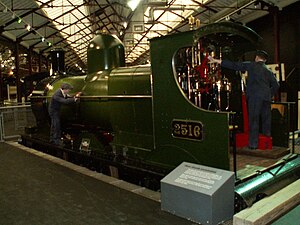GWR class 2301
| GWR class 2301 DR 53 7607 II / SNCF 030W / FS 293 |
|
|---|---|
|
Locomotive No. 2516 preserved in the Swindon Steam Railway Museum
|
|
| Numbering: | GWR 2301-2580 DR 53 7607 SNCF 030W001-045 |
| Number: | 280 |
| Year of construction (s): | 1883-1899 |
| Retirement: | Mid 1950s |
| Axis formula : | C n2 |
| Gauge : | 1435 mm ( standard gauge ) |
| Length over buffers: | 15,605 mm |
| Height: | 3,837 mm |
| Fixed wheelbase: | 4,724 mm |
| Total wheelbase: | 4,724 mm |
| Wheelbase with tender: | 11,979 mm |
| Smallest bef. Radius: | 90.5 m |
| Service mass: | 36.16 t |
| Service mass with tender: | 73.11 t |
| Friction mass: | 36.16 t |
| Wheel set mass : | 13.0 t / 13.0 t / 10.16 t |
| Driving wheel diameter: | 1,600 mm |
| Number of cylinders: | 2 |
| Cylinder diameter: | 444 mm |
| Piston stroke: | 610 mm |
| Boiler overpressure: | 12.4 bar |
| Number of heating pipes: | 6th |
| Number of smoke tubes: | 36 |
| Grate area: | 1.44 m² |
| Radiant heating surface: | 9.89 m² |
| Tubular heating surface: | 89.27 m² |
| Superheater area : | 7.00 m² |
| Evaporation heating surface: | 106.16 m² |
| Service weight of the tender: | 36.15 t |
| Water supply: | 11.36 m³ |
| Fuel supply: | 5.00 t |
The class 2301 of the Great Western Railway , also called "Dean Goods" after its designer, was a triple-coupled tender locomotive for light freight train service. The design of the locomotive came from the chief engineer of GWR William Dean and is considered his best known development. The locomotives proved themselves very well in use and were therefore in service until the mid-1950s. The locomotives had inner frames and cylinders. Only number 2516 in the Swindon Steam Railway Museum has survived .
War effort
During the First World War , 32 of these machines were in service outside of Great Britain . 2308 and 2542 came as ORC 110-111 to the Ottoman Railway Company (ORC) in the Asian part of Turkey , which they used on their route network east of Izmir . 110 went to the Turkish state railway TCDD after the nationalization of the ORC in 1935 , which it used as TCDD 33 041 .
Of the 180 pieces still in existence at that time, 108 pieces came to the British War Department as WD 93–200 during World War II . In Great Britain, 29 pieces were used to transport rail-mounted cannons that were supposed to prevent an invasion by the German Reich . Ten machines were fitted with an exhaust steam condensation device to make them more difficult to see from the air.
From October 1939 to April 1940, 79 machines were shipped to France. Many of these locomotives were either destroyed or captured by the enemy in the course of the fighting. 35 were classified by the SNCF as between 030W1 and 030W45. Others were in use in the north region with WD company numbers. At the SNCF, many machines were given a larger driver's cab, which offered better protection in bad weather.
After the end of the war, 34 units were still available on French territory and 22 had been sold to China , where they were classified as XK3 . Nothing is known about the use and whereabouts. Because of their low performance for China, however, they were probably used in industrial companies. The machines that remained in France were brought back to Great Britain and scrapped. An unknown number had been scattered across the war zone by the German troops.
Numbers 2521, 2463, 2548, 2545, 2478 and 2451 came to Italy in 1946 , where they formed the FS 293 series and were used in shunting in Ancona and Rimini before being retired in 1953.
The whereabouts of locomotive No. 2552
The locomotive with the number 2552 was taken over by the British War Department under the number 200 in 1939. The vehicle became the spoils of war in northern France in June 1940 and was numbered 142 at the command of the railway troops. In 1946 the locomotive was found in the Dresden Railway Directorate and in 1948, after being reconditioned, it was classified as 53 7607 II . In 1955 it was taken out of service.
The dimensions and masses of the locomotive and tender given by the DR differ from the original information, which indicates some modifications.
The whereabouts of locomotive No. 2435
Locomotive No. 2435, built in Swindon in 1893 , was taken over by the War Department as No. 188 in 1939, shipped to France in 1940 and captured by German troops near Dunkirk . It was completely overhauled in Cottbus and brought to Austria by German troops , where it was parked. In this condition she was captured by Soviet troops and used in the Soviet zone of Austria.
A photo from 1948 in Hütteldorf shows it with a driver's cab that is larger than the original version. Eventually it was scrapped in 1952.
literature
- Foreign locomotives in Austria , Bahn im Bild 83, Verlag Pospischil, 1992
- R. Tourret: Allied Military Locomotives of the Second World War , Tourret Publishing, Abingdon, 1976, 1977, 1995, ISBN 0-905878-06-X
Individual evidence
- ^ AE Durrant: The Steam Locomotives of Eastern Europe. David & Charles, Newton Abbot 1972, ISBN 0-7153-4077-8 , p. 79


